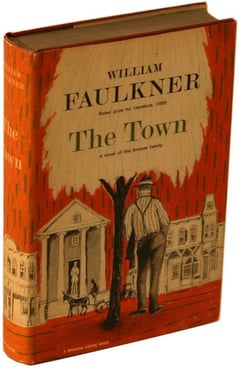Whether you’re simply visiting Oxford, Mississippi and the University of Mississippi (“Ole Miss”), or you’ve plotted out a road trip to the Deep South to visit the home of William Faulkner, we’d like to tell you more about “Rowan Oak,” the home of the Nobel Prize-winning writer. Located a short drive off I-55 in Mississippi, Rowan Oak is now owned by the University of Mississippi and is open to the public as a museum space. Faulkner owned the home for much of his adult life. Visitors to the home can learn more about Faulkner’s private life, his working space, and the area of the country that inspired the writer’s fictional Yoknapatawpha County in which many of his works were set.
Learning More About the History of Rowan Oak
 William Faulkner was born in Mississippi in 1897 and spent many of his early and teenage years in Oxford. In 1930, after marrying Estelle Oldham, he purchased a house that was then known as “The Bailey Place.” Colonel Robert Sheegog, an Irish immigrant who had come most recently from Tennessee, built the house in the 1840s. When Faulkner bought the home, no one had lived on the property for seven years. A year after buying “The Bailey Place,” Faulkner renamed it “Rowan Oak,” and purchased some of the area surrounding the house, known as “Bailey’s Woods.” Faulkner and his family would live in the house until the writer’s death in 1962. In the early 1930s, Faulkner and Estelle lived at Rowan Oak with Estelle’s children from a previous marriage, Malcolm and Victoria. Soon after, Jill, Faulkner’s daughter with Estelle, was born.
William Faulkner was born in Mississippi in 1897 and spent many of his early and teenage years in Oxford. In 1930, after marrying Estelle Oldham, he purchased a house that was then known as “The Bailey Place.” Colonel Robert Sheegog, an Irish immigrant who had come most recently from Tennessee, built the house in the 1840s. When Faulkner bought the home, no one had lived on the property for seven years. A year after buying “The Bailey Place,” Faulkner renamed it “Rowan Oak,” and purchased some of the area surrounding the house, known as “Bailey’s Woods.” Faulkner and his family would live in the house until the writer’s death in 1962. In the early 1930s, Faulkner and Estelle lived at Rowan Oak with Estelle’s children from a previous marriage, Malcolm and Victoria. Soon after, Jill, Faulkner’s daughter with Estelle, was born.
How did the University of Mississippi come to own Rowan Oak? After Faulkner’s death, his daughter Jill Summers Faulkner sold it to Ole Miss, according to the museum website*, “to secure it as a place for people worldwide to learn about her father and his work.”
Visiting the Property
 What will you find inside Rowan Oak? The house is two stories. On the first floor, the library, parlor, dining room, office (Faulkner’s writing room), back hall, and kitchen are all open to visitors. The indoor kitchen is painted a shade of light grey-blue that’s reflected in other rooms of the house. Yet what is so notable about a visit to the inside of the house is not the color palette. Rather, the most exciting details for a Faulkner reader can be found on the walls of the office, where the Nobel Prize winner outlined the plot of A Fable (1954), which won both the Pulitzer Prize and the National Book Award.
What will you find inside Rowan Oak? The house is two stories. On the first floor, the library, parlor, dining room, office (Faulkner’s writing room), back hall, and kitchen are all open to visitors. The indoor kitchen is painted a shade of light grey-blue that’s reflected in other rooms of the house. Yet what is so notable about a visit to the inside of the house is not the color palette. Rather, the most exciting details for a Faulkner reader can be found on the walls of the office, where the Nobel Prize winner outlined the plot of A Fable (1954), which won both the Pulitzer Prize and the National Book Award.
Upstairs, visitors can see Estelle’s bedroom, Faulkner’s bedroom, and the children’s bedrooms. On both floors, there are specific rooms that are not open to the public and thus are not available for viewing during a tour. In addition to the interior of the house, visitors are welcome to explore the exterior of the property, which includes a detached kitchen and smokehouse, a barn, a stable, and numerous walkways through Bailey’s Woods. Faulkner converted the outdoor kitchen to a smokehouse at some point during the 1930s to smoke and store hams. The writer kept his horses in the stable.
If you plan to visit Faulkner's home, be sure you plan according to the museum’s schedule. The house is open for visitors between 10:00 a.m. and 4:00 p.m. Tuesday through Saturday, and from 1:00 p.m. until 4:00 p.m. on Sundays. The summer hours are extended. Entrance to the house costs only a $5 admission fee per person, and materials for the tour are available in multiple languages. Have fun!
*View the full website here.









